Download CBSE Class 8 Science Force And Pressure Notes in PDF format. All Revision notes for Class 8 Science have been designed as per the latest syllabus and updated chapters given in your textbook for Science in Class 8. Our teachers have designed these concept notes for the benefit of Class 8 students. You should use these chapter wise notes for revision on daily basis. These study notes can also be used for learning each chapter and its important and difficult topics or revision just before your exams to help you get better scores in upcoming examinations, You can also use Printable notes for Class 8 Science for faster revision of difficult topics and get higher rank. After reading these notes also refer to MCQ questions for Class 8 Science given on studiestoday
Revision Notes for Class 8 Science Chapter 11 Force and Pressure
Class 8 Science students should refer to the following concepts and notes for Chapter 11 Force and Pressure in Class 8. These exam notes for Class 8 Science will be very useful for upcoming class tests and examinations and help you to score good marks
Chapter 11 Force and Pressure Notes Class 8 Science
FORCE & PRESSURE
INTRODUCTION
We use force all the time. We use force to open a door, to pick up the school bag, to brush our teeth, to squeeze out toothpaste from a tube, to turn on a tap and so on. Even the earth is exerting a force on us all time. It is pulling all of us and all things on earth towards it.In fact we use force for every single action of ours! You have studied about force in previous classes. Do you remember what a force is ?
NOTE :
• Force has a sense of direction also. It means that we can apply the same amount of force in different direction, producing different effects.
• Without source force cannot be possible.
UNIT OF FORCE
(i) The SI unit (in standard international system) of force is called Newton and its symbol is N (kg × m/sec2)
(ii) C.G.S unit of force is dynes (gm cm/s2)
1 Newton = 105 dynes,
1 N = kg – m/s2
= 1(1000 gm) (100 cm/s2)
= 105 gm–cm/s2
So that 1 N = 105 dyne
EFFECT OF FORCE
1. FORCE CAN MOVE A BODY LYING AT REST
(a) Kicking a stationary football. (b) Lifting a book kept on a table top. (c) Hitting a stationary ball with a bat.
2. FORCE CAN STOP A MOVING BODY
Example :
(a) A goalkeeper stopping a football moving towards the goal post.
(b) A moving bicycle coming to rest on applying brakes. Here the frictional force between the brake lining of the brake shoe and the bicycle wheel rim, acts to stop the bicycle.
3. FORCE CAN CHANGE THE SPEED OF A MOVING BODY
Ex. To decrease speed, force is applied in a direction which is opposite to the motion of the body. If we apply force in the direction of motion of the body, it tends to increase the speed of the body. For example, if your friend is riding a bicycle and you push the bicycle in the same direction. The speed of bicycle will increase. On the other hand if you pull the bicycle, i.e., you apply force against the direction of motion, the speed of bicycle decreases
4. FORCE CAN CHANGE THE DIRECTION OF A MOVING BODY
Example :
(a) A carrom counter changes its direction after a collision.
(b) When a batsman hits a ball, he changes the direction of the ball.
(c) When a stone is rotated in a circular path, the direction of motion of the stone change continuously. The force acting on the stone towards the centre of the circular path is responsible for changing the direction ofthe stone.
(d) A football player hitting a ball coming towards him, towards the goal post.
5. FORCE CAN CHANGE THE SHAPE AND SIZE OF AN OBJECT
Example :
(a) When we squeeze a toothpaste tube, it gets flattened.
(b) When we stretch a rubber band, its shape and size changes.
(c) On stretching a spring, its length changes.
6. FORCE CAN MAKE A BODY ROTATE.
Example :
(a) When electric current is passed through a motor of a ceiling fan, forces are produced in the dynamo (or motor) which makes the fan to rotate.
(b) For closing a door you apply a push.
(A) CONTACT FORCE : When a force involves direct contact of two bodies we call the force a contact force.
(i) FRICTIONAL FORCE :– The force which acts to reduce relative motion between the surfaces of contact is called the frictional force.
Suppose a block is moving on a horizontal surface with a velocity υ. The darkened line at the bottom of the block is the surface of contact of the block with floor. We notice that this surface of contact is moving towards right with respect to the horizontal surface. To reducing this relative motion, frictional force acts. Frictional force is exerted by the floor on the block in a direction opposite to velocity.
(ii) NORMAL FORCE : The force acting on a body perpendicular to the surface of contact is called a normal force.
NOTE : Tension and spring force are also contact forces.
(iii) MUSCULAR FORCE : The force resulting due to the action of muscles is known as the muscular force. Animals also make use of muscular force to carry out their physical activities and other tasks. Animals like bullocks, horses, donkey and camels are used to perform various tasks for us. In performing these tasks they use muscular force. Since muscular force can be applied only when it is in contact with an object. This force is also known as Biological force.
(iv) MECHANICAL FORCE : The force exerted by a machine is called mechanical force. Machines do not produce force by themselves. In order to produce force they need energy from other sources. Mechanical force produced by a car engine, and mechanical force produced by the turbines in a hydroelectric power station are examples of Mechanical force.
(B) NON-CONTACT FORCE
The force which a body applies on another body when the two bodies are not in contact with each other is called non-contact force.
(i) GRAVITATIONAL FORCE : The force of attraction which one body exerts on the other because of their masses is called gravitational force.
Gravitational force is the weakest force in nature and still this force is responsible for the revolution of earth around the sun.
Force of gravity on a body is equal to the true weight of the body.
The force with which earth attracts a body is called the force of gravity. A body of mass m is attracted by earth towards its centre. This force is also called the weight (W) of the body.
W = mg
Fact File
We have read about different types of forces such as muscular, frictional gravitational, electrostatic force, magnetic force, tension, weight, viscous force, etc. But forces are fundamentally classified into four groups (a) Gravitational force (b) weak force (c) Electromagnetic force (d) Nuclear force. Scientists believe that these four groups also belong to a single type of force which is unknown to us as of date.
(ii) ELECTROSTATIC FORCE : The force which results due to the repulsion of similar charges or attraction of opposite charges is called electrostatic force. If we rub a plastic object like a pen or a comb with hair and bring it close to tiny bits of paper, the bits of paper get attracted to the plastic object. This is due to electric force. Tiny particles of dust and smoke can also be attracted by electrostatic force. This method is used in air purifiers and in factories to purify air in chimneys, before letting it escape into the atmosphere.
(iii) MAGNETIC FORCE : This is the force exerted by magnets on each other and on some metals like iron and nickel. Since magnets attract iron, magnets are used to separate waste iron object form garbage dumps so that they can be recycled. Magnetic force and electrostatic force are inter-related and are together called electro-magnetic force.
COMPETITION WINDOW
MASS
The amount of matter contained in a body is called its mass
O R
The measure of the quantity of matter in a body is called its mass.
The mass of a body is a scalar quantity. It is independent of surroundings and the position of the body.
It is a constant quantity for a given body.
Mass is measured in kilogram (kg) in S.I. System.
WEIGHT
Everybody on the surface of earth is attracted towards the centre of the earth. The force of attraction depends upon the mass of the body and the acceleration due to gravity. The weight of the body is the force with which it is attracted towards the centre of the earth. We know
F = ma
The acceleration produced by the force of attraction of the earth is known as acceleration due to gravity i.e., g
∴ F = ma = mg
But by definition this force is equal to the weight of the body i.e., F = W.
∴ W = mg
SI unit of weight is newton (N) and in CGS, it is measured in dyne (dyn).
SPRING BALANCE
A spring balance is a device used to measure the weight of an object. It can also be used for the measurement of forces.
Weighing machines which are used in schools or hospitals are also spring balances.
ACTIVITY
MAKING OF A SPRING BALANCE
Take a spring and hang it from a stand. Attach a pointer near the free end of the spring. Fix a strip of cardboard by the side of the spring and mark '0'. Now suspend a 10 g load from the lower end. Mark 10 g force against the new position of the pointer. Add another 10 g load to the lower end of the spring. The length of the spring increases. Mark 20 g against the new position of the pointer on the strip. Go on adding loads in steps of 10 g and mark the new position of the pointer on the cardboard as 30, 40, 50. Your spring balance is now ready for use.
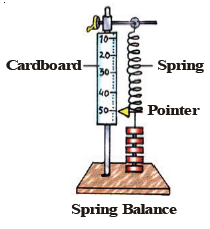
MEMORIES :– Spring applies force on both ends. These forces are equal in magnitude but opposite in direction.
A spring balance consists of a spring inserted in a metal tube. The metal tube has a vertical slop through which the pointer comes out. The object to be weight is suspended on the hook at the bottom. When the object comes to equilibrium it stretches the spring. As a result, the pointer comes down and shows the reading against a scale.
RESULTANT FORCE If a single force acting on a body produces the same acceleration as produced by a number of forces, then single force is called the resultant of these individual forces. The resultant force is also called the net force. Ex. Suppose an almirah is being pushed by two persons A and B. Let the force applied by A be F1 = 2N and that by B be F2 = 3N. These two forces together will result in some displacement of the almirah in a given time. In another situation, a person C is pushing the same almirah kept initially in the position as that of the previous situation. The person C is applying a force F = 5N in the same direction as that of A and B.
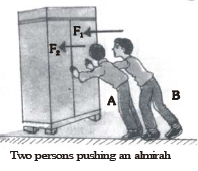
BALANCED FORCES When the force acting on a body cancel out the effects of each other in such a way that the resulting force is zero, then these forces are said to be balanced. Ex. Let us consider a rigid almirah kept at rest on a horizontal surface. Let two forces F1 and F2 act simultaneously on the almirah from opposite directions. If the two forces are equal, the effects produced by one force get cancelled by the effect produced by the other. The net force or the resultant force is then zero. The almirah continues to remain at rest. When a numbers of forces acting on a body do not cause any change in its state of rest, or of uniform motion is a straight line then the force are said to be banalced forces.
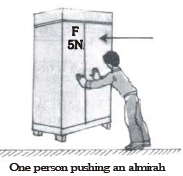
UNBALANCED FORCES
If number of forces acting on a body produce an acceleration in the body, then the forces acting are called unbalanced.
Suppose F1 = 5 newton and F2 = 3 Newton. In this case a resultant force is acting on the almirah towards the direction of F1. We say that an unbalanced force of 2 Newton will act on the almirah towards the direction of F1.
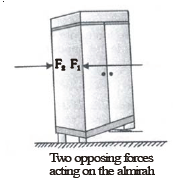
Mathematical Representation of force : Mathematically, force F is equal to the product of mass M of a body and acceleration, a produced in the body due to that force. i.e. F = ma
Acceleration : Mostly the velocity of a moving object changes either in magnitude or in direction or in both when the object moves. The body is then said to have acceleration. So it is the rate of change of velocity i.e.
change in velocity in unit time is said to be acceleration. ( it is vector quantity)
Its SI. unit is m/s2 & C.G.S. unit is cm/s2
Gravitational force : According to Newton
"Every body in the universe attract another body with a force which is directly proportional to product of their masses and inversely proportional to square of the distance between them."
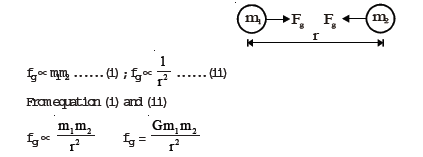
ELECTROSTATIC FORCE : According to "Coloumb"
"The force acting between the charges is known as electric force." If q1 and q2 are the charges then the force acting between them would be,
F = Kq1q2/r2
Where 'r' is the distance between q1 and q2, K is the Coulomb's constant Force can be attractive or repulsive.
It is defined as the force per unit area. The SI unit of pressure is pascal (Pa), which is Newton per square metre.
Pressure (in Pa) = Fo rce(in newto n)/Area (in m ) x [P = F/a]
Ex. If a force of 2 N is applied over an area of 2 cm2, calculate the pressure produced.
Sol. To get the pressure in Pa, we have to make sure that the force is in Newton and the area in m2.
Here, the area is in cm2. To convert this to m2, we have to divide the given are a by 10, 000
Thus, area = 2 / 10,000 = 0.0002 m2 (Image 8)
Ex. Calculate the pressure if a force of 2N is applied on an area of 2 mm2. Here, again the area is not in m2. To change it into m2, we divide the area by 1, 000,000.
VARIATION OF PRESSURE WITH AREA
The same force, increasing the area over which it acts decreases the pressure applied. The inverse is also true: decreasing the area of application increases the pressure produced for the same force.
Ex. The area under the edge of a knife's blade is extremely small.
Beneath it the pressure is high enough for the blade to push easily through the material that needs to be cut.
Wall foundations have a large horizontal area. This reduces the pressure underneath so that the walls do not sink further into the ground under the weight of the building.

FLUID PRESSURE
Liquids and gases are together called fluids.
Fluids exert pressure on all bodies immersed in them and on the walls of the container that holds them. The air inside the balloon exerts a pressure on the inner walls of the balloon.
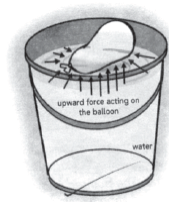
ATMOSPHERIC PRESSURE
A layer of air called the atmosphere surrounds the earth. As you know, air is also matter and has weight. The weight of the atmosphere exerts a pressure on the surface of earth. This pressure is called atmospheric pressure. Its magnitude is around 100 kilo pascals (100 kPa) at sea level. However, as we go upward, the magnitude of atmospheric pressure decreases gradually. The following activity will show the magnitude of atmospheric pressure on the earth's surface. (Image 9)
ACTIVITY
THE MAGNITUDE OF ATMOSPHERIC PRESSURE
Take a glass tumbler and fill it with water to the brim. Cover it with a thick sheet of paper (or cardboard). Press your palm over the sheet and quickly invert the tumbler. Slowly remove your palm supporting the piece of paper. What do you observe? Surprised?
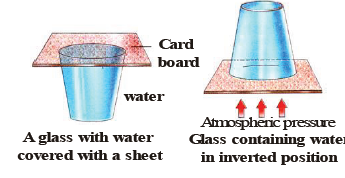
You have seen that the paper did not fall (as one expected it to.) This is because the atmospheric pressure provides enough force to push the piece of paper upward.
Fact file
It has been found that when deep-sea fish are brought to the surface of the sea, their bodies burst. It is because the blood in their bodies flows at very high pressure. At the surface of the sea, the pressure outside decreases.
This difference in pressure causes their bodies to burst open.
If the air exert such a huge pressure, why do our bodies not get crushed? It is because our blood contains dissolved oxygen at a pressure that is slightly more than the atmo spheric pressure.
This counterbalances the atmospheric pressure.
BAROMETER
A barometer is a device used for measuring the atmospheric pressure.
Atmospheric pressure measurements are important to meteorologists for weather forecasts. The unit of pressure used for meteorological purpose is called the bar. A bar is a CGS unit of pressure and equals 105 pascals or 1 bar = 105 Nm–2.
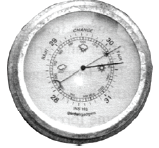
LIQUID PRESSURE : A liquid exerts pressure on the wall of the container
Take some discarded plastic bottle and fix a glass tube near its bottom. It can be done by slightly heating one end of the glass tube and then inserting it near the bottom of the bottle. In case there is some leakage, your must seal it with molten wax. Now cover the free end of the glass tube with a thin rubber sheet. On filling the plastic bottle upto half with water, the rubber sheet fixed to the glass tube bulges. When more water is added in the plastic bottle, there is change in the bulge of the rubber sheet. Since the rubber sheet is fixed on the side of the container, it shows that water exerts pressure on the side of the container. In other words, liquids exert pressure on the walls of the container.
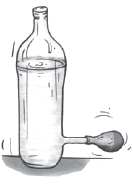
MANOMETER
It is an a instrument used to measure liquid pressure. An open tube manometer is a simplest type of pressure gauge which measures pressure. It consists of a U-shaped tube containing a liquid. One arm of the tube is open to air and the other arm is connected to the vessel in which we want to measure the pressure. The difference in liquid level represents the applied pressure.
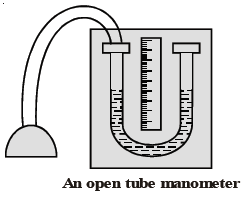
ACTIVITY
AIR PUMP
In 1654, a German scientist Otto van Guericke invented a pump to evacuate air from a vessel. To demonstrate the force of air pressure, he joined two metallic hemispheres and pumped out air inside it. He employed two terms of eight horses to pull each hemisphere apart. The hemispheres could not be separated by eight horses pulling the hemispheres from opposite directions. It is because the hemispheres were held together by the air pressure from outside and was so large that even 16 horses could not overcome it.
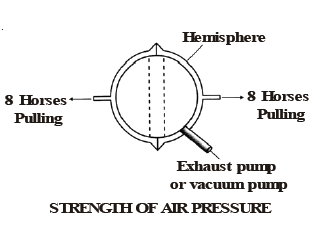
OTHER APPLICATIONS OF PRESSURE
(a) Drinking straw Straw is used to suck up aerated water, when air is sucked in, it causes a decrease in air pressure inside the straw. The outside atmospheric pressure forces the liquid inside the straw. The droper also works on the same principle. This is known as suction mechanism.
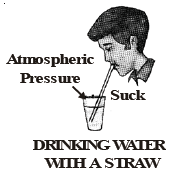
(b) Syringe In syringe the pressure of the liquid (blood) force the liquid to move into the syringe when its plunger is withdrawn.
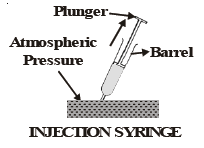
(c) Vacuum cleaner A vacuum cleaner is an electrical appliance that cleans by suction. A fan inside the vacuum cleaner lower the air pressure and creates a low pressure the device. As a result, the air and dirt particles on and near the surface are sucked into the device.
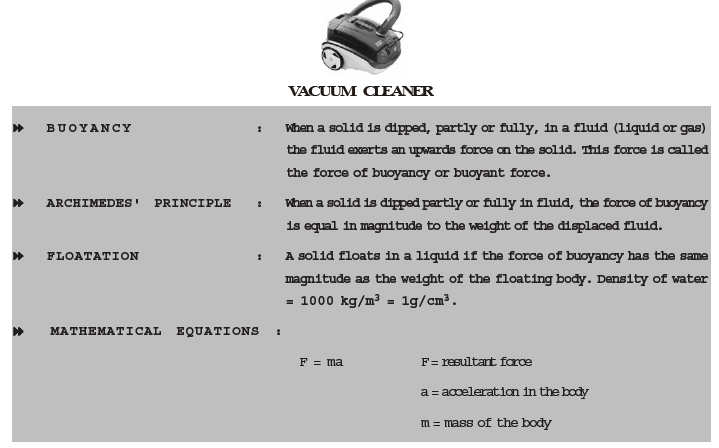
LOOKING BEYOND
Blaise Pascal : (1623-1662) was a French physicst and mathematician. When he was only three years old, his mother died, then his father devoted himself to the upbringing of the child.
He was the first to construct a calculating machine, he demonstrated atmospheric pressure, established theoretical principles for the hydraulic transmission of power and also contributed extensively to mathematics.
Following an intense religious experience in 1654, he gave up science, mathematics and technology and devoted himself to religious philosophy. He died before he was forty, having worked three careers into a short life.
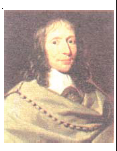
An instrument called sphygmomanometer is used to measure the blood pressure of humans. The blood pressure of a person is the ratio of systolic (maximum) and diastolic (minimum) pressures. Normally it is 120/80 mm of Hg in a healthy adult. Pressures above 140/90 needs medical attention.

SUMMARY
A push or a pull acting on a body is called 'force'. Its unit is Newton.
A force can : (i) move a body (ii) stop a moving body (iii) change the speed of a moving body (iv) change the direction of a moving body, and (v) change the shape and size of objects.
Contact forces act only when the interacting objects are in contact. Non-contact forces act from a distance.
Weight is a force.
Pressure is the physical quantity that combines force and the area over which it acts.
A liquid exerts pressure in all directions.
Liquid pressure increases with depth, whereas pressure is same in all directions at the same depth.
The pressure at any point under a liquid surface is due to the weight of the column of liquid above that point.
Liquid pressure is measured with a manometer.
The pressure exerted by air is called atmospheric pressure. It is exerted equally in all directions.
Atmospheric pressure reduces as height above sea level increases.
KEY WORDS
Forces : Push or pull acting on a object.
Contact force : A force that acts upon another body through some material connector.
Non-connected force : A force that acts upon another body without the aid if a material connector.
Muscular force : The force produced by the muscles of living beings.
Weight : The pull (force) by which an object is attracted towards the earth.
Fluid : A substance that can flow (both liquids & gases.)
Manometer : A device used for measuring liquid pressure.
OBJECTIVE TYPE QUESTION
Question. If a rock is brought from the surface of the moon :
(A) Its mass will change
(B) Its weight will change, but not mass.
(C) Both mass and weight will change
(D) Its mass and weight will remain the same.
Answer : B
Question. When an object undergoes acceleration :
(A) Its speed always increases
(B) Its velocity always increases
(C) It always falls towards the earth
(D) A force always acts on it
Answer : D
Question. External forces are :
(A) Always balanced
(B) Never balanced
(C) May or may not be balanced
(D) None of these
Answer : C
Question. The net force acting on a body of mass 1 kg moving with a uniform velocity of 5 ms–1 is :
(A) 5 N
(B) 0.2 N
(C) 0 N
(D) None of these
Answer : C
Question. How many dynes are equal to 1 N?
(A) 106
(B) 104
(C) 105
(D) 103
Answer : C
Question. A force can :
(A) Change the direction of a moving body
(B) Change the state of rest or uniform motion of a body.
(C) Change the shape of a body
(D) All of the above
Answer : D
Question. The S.I. unit of pressure is –
(A) Newton
(B) Dyne/cm2
(C) Pascal
(D) Joule
Answer : C
Question. Which among the following will exert maximum pressure when pushed with the same amount of force?
(A) An eraser of area 2 cm2
(B) A sharpened pencil tip
(C) The blunt end of a pencil
(D) The rear portion of a closed safety pin
Answer : B
Question. Pressure is also measured in :
(A) Joule
(B) mm of Hg
(C) mm of Ag
(D) Metre
Answer : B
Question. Force per unit area is called :
(A) Energy
(B) Work
(C) Pressure
(D) Thrust
Answer : C
Question. Atmospheric pressure is measured by :
(A) Barometer
(B) Manometer
(C) Screw gauge
(D) None of these
Answer : A
Question. A manometer is used to measure :
(A) Height
(B) Pressure
(C) Liquid density
(D) Atmospheric pressure
Answer : B
Question. How does pressure vary as we come from mountain top to sea level?
(A) Increases
(B) Decreases
(C) Remains same
(D) Depends on weather
Answer : B
Question. As we go deeper beneath the surface of liquid, the pressure :
(A) Remains same
(B) Increase
(C) Decreases
(D) Depends on weather
Answer : A
Question. A vacuum cleaner works on the principle of :
(A) Electromagnetic Induction
(B) Suction
(C) Mutal Induction
(D) Energy conservation
Answer : B
Question. The S.I. unit of force is :
(A) metre
(B) Newton
(C) Pasca
l (D) Second
Answer : B
Question. A contact force cannot act through
(A) Empty space
(B) Touching
(C) Touching with a metal rod
(D) Touching with a wooden rod
Answer : A
Question. Which of the following is a unit of pressure?
(A) Metre
(B) Newton
(C) Square metre
(D) Pascal
Answer : D
Question. Deep-sea diving vessels have to withstand pressure from the crushing effect of sea water acting :
(A) Upwards
(B) Downwards
(C) Side ways
(D) In all directions.
Answer : A
Question. Which among the following will exert maximum pressure when pushed with the same amount of force?
(A) An eraser of area 2 cm2
(B) A sharpened pencil tip
(C) The blunt end of a pencil
(D) The rear portion of a closes safety pin.
Answer : D
Question. Which of the following is a type of a pressure gauge?
(A) Speedometer
(B) Manometer
(C) Syringe
(D) Thermometer
Answer : B
Question. Which of these is not a contact force?
(A) Friction
(B) Muscular force
(C) Magnetic force
(D) None of these
Answer : C
Question. A force has :
(A) Magnitude only
(B) Direction only
(C) both magnitude and direction
(D) None of these
Answer : C
Question. When a force is applied on a body it may change its
(A) Speed only
(B) Direction only
(C) both speed and direction
(D) None of these
Answer : C
Question. When we press the bulb of a dropper with its nozzle kept in water, air in the dropper is seen to escape in the form of bubbles. Once we release the pressure on the bulb, water gets filled in the dropper. The rise of water
in the dropper is due to :
(A) Pressure of water
(B) Gravity of the earth
(C) Shape of rubber bulb
(D) Atmospheric pressure
Answer : D
Question. Gravitational force acts :
(A) Only between the sum and the planets moving around it.
(B) Only between the earth and the bodies on it
(C) Between all bodies in the universe
(D) Only between the sun and the earth
Answer : C
Question. The relation between the S.I. unit of force and the weight of a 1 kg mass is :
(A) 1 kg of = 1 N
(B) 1 kg of = 0.98 N
(C) 1 kg of = 9.8 N
(D) 1 N = 9.8 kg
Answer : C
Question. If a force of 100 N acts on an area of 10 m2, the pressure equal :
(A) 100 N/m2
(B) 10 N/m2
(C) 1000 N/m2
(D) 1000 Nm2
Answer : A
Question. 1 dyne is equal to :
(A) 980 g wt
(B) 1/980 g wt
(C) 980 kg wt
(D) None of these
Answer : B
Question. Which of the following class of force is different from others?
(A) magnetic force
(B) Electrical force
(C) Gravitational force
(D) Stretching of a spring
Answer : D
FILL IN THE BLANKS
Question. The ............. or push acting on a body is commonly called force
Answer : Pull
Question. The force of gravity is a ............. force.
Answer : Gravitational
Question. Hydraulic press is based on .............
Answer : Gravity
Question. To draw water from a well we have to ............. at the rope.
Answer : Downward
Question. A charged body ............. an uncharged body towards it.
Answer : Attarct
Question. To move a loaded trolley we have to ............. it.
Answer : Pull
Question. The north pole of a magnet ............. the north pole of another magnet.
Answer : Repal
Question. To stretch the how, the archer applies a force that causes a change in its .............
Answer : Position
Question. The force applied by the archer to starch the bow is an example of ............. force.
Answer : Contact
Question. A manometer is used to measure .............
Answer : Pressure difference
Question. Pascal (Pa) is the unit of .............
Answer : Pressure
Question. ............. and ............. are together called fluids.
Answer : Gas, Liquids
Question. An instrument used to measure ............. is called a pressure gauge.
Answer : Push or pul
Question. Pressure is also measured in .............
Answer : pushes
Question. Hydraulic devices are based on .............
Answer : Pascal's Law
Please click the link below to download pdf file for CBSE Class 8 Science Force and Pressure Chapter Notes.
Q1. What is force? State the various effects of force.
Ans. A push or pull on an object is called force.
Effects of force:
(i) Force can change the speed of a moving object.
(ii) Force can change the direction of a moving object.
(iii) Force can change the shape of an object.
Q2. Give one example where force can changes the
(a) Speed of a moving object
(b) Direction of a moving object.
(c) the shape of an object.
Ans. (a) The force applied by a hockey player on a moving ball changes the speed of ball.
(b) The force applied by a batsman changes the direction of moving cricket ball.
(c) Force applied on a spring can change its shape.
Q3. Identify the actions involved in the following situations as push or pull, or both:
(a) Opening a drawer.
(b) Moving a loaded cart.
(c) A cricket ball hit by a batsman.
(d) Drawing a bucket of water from a well.
Ans. (a) Pull. (b) Push; Pull. (c) Push (d) Pull
Note: a) At least two objects must interact for a force to come into play.
b) Force applied on an object in the same direction add to one another.
c) If the forces act in the opposite directions on object, the net force acting on it is the difference between the two forces.
d) The state of motion of an object is described by its speed & the direction of motion. So we can say that a force can change the state of motion of an object.
e) S.I unit of force is Newton ( N).
Q4. In a tug of war, when the two teams are pulling the rope, a stage comes when the rope does not move to either side at all. What can you say about the magnitudes & directions of the forces being applied to the rope by the two teams at this stage?
Ans. At this point of time, the two teams are applying equal but opposite forces to the rope due to which the net force acting on the rope is zero & hence the rope does not move.
Q.5. What is meant by a contact force?
Ans. A force that can be applied only, when an object comes in direct contact with an another object is called contact force. Eg. Muscular force & Frictional force.
Q.6 What is muscular force?
Ans. The force resulting due to the action of muscles is called muscular force. Eg pushing an object or lifting a bucket of water.
Note: Since muscular force can be applied to an object only when our body is in contact with the object, therefore, muscular force is a contact force.
Q.7 What is meant by non-contact force?
Ans. A force that can be applied by an object on another object even from a distance (without touching) is called a non-contact force. Eg. Magnetic force, Electrostatic force & Gravitational force.
Q.8 A small device pulls iron nails from a distance. Which type of force is involved in this process?
Ans. Magnetic force
Q.9 What is electrostatic force?
Ans. The force exerted by a charged body on another charged or uncharged body is known as electrostatic force.
Q.10 When a plastic pen is rubbed in dry hair, it attracts tiny pieces of paper. Which force is involved in this process?
Ans. Electrostatic force.
Q.11 What is meant by gravitational force?
Ans. Every object in this universe attracts every other object with a force, called gravitational force.
Q.12 What is meant by Force of gravity?
Ans. The force, with which the earth pulls the objects towards it, is called the force of gravity or simply gravity.
Q.13 A coin falling to the ground on slipping from hand. Name the type of force involved in this process?
Ans. Gravitational force.
Q.14 Define pressure.
Ans. The force acting on unit area of surface is called pressure.
Pressure = Force / Area.
Unit of pressure is N/m2 (Newton per square metre) which is also called Pascal (Pa).
Note: Pressure is inversely proportional to area. Therefore smaller the area, larger the pressure on a surface for the same force.
Q.15 Explain why, school bags are provided with wide straps to carry them?
Ans. As a result the area of contact between the shoulders & the straps increases, thereby decreasing the pressure on the shoulders, as pressure is inversely proportional to area.
Q.16 Explain why, wooden sleepers are kept below the railway line?
Ans. So as to increase the area of contact between the rails & the ground, thereby decreasing the pressure on the ground, as pressure is inversely proportional to area. This prevents the sinking of rails into the ground.
Q.17 Why is it easier for a camel to run in a desert?
Ans. Camel has board feet causes an increase in the area of contact between the sand & its feet. As a result pressure exerted by camel on the sand decreases because pressure is inversely proportional to area. This prevents the sinking of its feet’s into the sand.
Q.18 How does the pressure of a liquid depends on its depth?
Ans The pressure exerted by a liquid increases with increasing depth inside the liquid..
Q.19 Where is the pressure greater, 10 m below the surface of the sea or 20 m below the surface of sea?
Ans. 20 m below the surface of sea.
Q.20 One student says that water exerts pressure on the bottom of the bucket but another student says that water exerts pressure on the sides of the bucket. What would you like to say?
Ans. Both the students are correct as water exerts pressure on the bottom as well as on the side walls of the container.
Q.21 Two tiny holes are made in a plastic bucket, one near the middle part & the other just above the bottom. When this bucket is filled with water, the water rushes out from the bottom hole much faster than from the upper hole. What conclusion do you get from these observations?
Ans The pressure exerted by a liquid increases with increasing depth inside the liquid..
Q.22 Explain why, the walls of dam are thicker near the bottom than at the top?
Ans The pressure exerted by a liquid increases with increasing depth inside the liquid. That’s why the wall of a dam is made thicker at the bottom (than at the top) so as to tolerate very high sideways pressure exerted by deep water.
Q.23 What is meant by atmospheric pressure?
Ans. The envelop of air around us is known as atmosphere. Now the pressure exerted by this air is known as atmospheric pressure.
Note:
(a) The atmospheric pressure is maximum at the sea level.
(b) As we go up in the atmosphere from the surface of earth, the atmospheric pressure goes on decreasing.
Q.24 What is the cause of atmospheric pressure?
Ans. The atmospheric pressure is due to the weight of air present in the atmosphere above us.
Q.25 Why are our bodies not crushed by the large pressure exerted by the atmosphere?
Ans. The reason that we are not crushed is that the pressures inside our bodies is also equal to the atmospheric pressure & cancel the pressure from outside.
Note: (a) At high altitudes, the atmospheric pressure becomes much less than our blood pressure. Therefore some of the blood vessels in our body burst & nose bleeding take place at high altitudes.
(b) Rubber suckers are usually used to hold objects with the help of suctions. When we press the sucker, most of the air between its cup & the surface escapes out. The sucker sticks to the surface because the pressure of atmosphere acts on it. If there is no air between the cup & the surface, than it would be impossible to pull the sucker off the surface.
NUMERICALS:
1. Calculate the pressure when a force of 200 N is exerted on an area of: (a) 10 m2 (b) 5 m2
2. What force acting on area of 0.5 m2 will produce a pressure of 500 Pa?
3. The tip of drawing pin has an area 1.0 x 10-8 m2. Find the pressure exerted if force applied is 10 N.
Force and Pressure Chapter Summary
Ex. : A ball of mass 20 gm is initially mov ing with a velocity of 100 m/s. On applying a constant force on the ball for 0.5s, it acquires a v elocity of 150 m/s. Calculate the following :
(i) Initial momentum of the ball (ii) Final momentum of the ball
(iii) Rate of change of momentum (iv) Acceleration of the ball
(v) Magnitude of the force applied
20
Sol. : Given , m = 20/1000 gm kg = 0.02 kg
Initial velocity, u = 100 m/s
Time interval, t = 0.5 s
Final velocity, v = 150 m/s
(i) Initial momentum of the ball = mass × initial velocity
or P1 = mu = 0.02 kg × 100 m/s = 2 kg-ms–1
(ii) Final momentum of the ball = mass × final velocity
or P2 = mv = 0.02 kg × 150 m/s = 3 kg-ms–1
(iii) Rate of change of momentum
= (Final momentum - Initial momentum) / Time= or ΔP/Δt = (3-2)/0.5 = 1/0.5 = 2.0 kg-ms–1 = 2.0N
(iv) Acceleration, a =v - u / t = 150 - 100/0.5 = 100ms–2
(v) Force, F =mass × acceleration = 0.02 × 100 = 2.0 N
Ex. : A cricket ball of mass 200 gm mov ing with a speed of 40 m/s is brought to rest by a player in 0.04s.
Calculate the following :
(i) change in momentum of the ball, (ii) average force applied by the player.
Sol. : Mass, m = 200 gm =200/1000 kg = 0.2 kg
Initial velocity, u = 40 m/s
Final velocity, v = 0
Time, t = 0.04s
(i) Initial momentum, p1 = mu = 0.2 kg × 40 m/s = 8.0 kg-ms–1
Final momentum, p2 = m × v = 0.2 × 0 = 0 kg-ms–1
Change in momentum, Δp = p2 – p1 = 0 – 8.0 kg ms–1 – 8.0 kg-ms–1
(ii) Average force = Change in momentum / Time = - 8.0 - 0 / 0.04 = – 200 N
(The negativ e sign shows that the force is applied in a direction opposite to the direction of motion of the ball).
Ex. : A motorcycle is moving with a velocity of 108 km/hr and it takes 5 s to stop it after the brakes are applied. Calculate the force exerted by the brakes on the motorcycle if its mass along with the rider is 250 kg.
Sol. : Given that initial v elocity of the motorcycle
= 108 km/hr = 30 m/s
Final velocity = 0 m/s
Time taken to stop = 5s, the mass of the motorcycle with rider = 250 kg.
The change in the velocity of the motorcycle in 5s = 0 – 30 = –30 m/s
Therefore, the acceleration of the motorcycle, a = -30/5 = –6 m/s2
The magnitude of the force applied by the brakes is given by the equation,
F = mass × acceleration
= 250 kg × (6)m/s2 = 1500 N
(C) Newton's third law of motion
• Newton's first law of motion gives a qualitative idea of force, while the second law provides us an idea to measure the force.
• Newton's third law of motion states that " if a body A exerts a force on the body B, the body B will also exert an equal and opposite force on A."
• The force exerted by A on B is called action while the force exerted by B on A is called the reaction.
• Newton's third law is also stated as "to ev ery action there is an equal and opposite reaction."
• Action and reaction always act on different bodies.
• eg. by hitting a table with palm we apply a force. The table also exerts a force on palm on hitting it.
• Forces always occur in pairs.
Applications of Newtons III law :
• Recoil of a gun – where the bullet is fired from a gun, an equal and opposite force is applied on the gun, due to which the gun recoils in backward direction.
• Application in walking : while moving in forward direction we push the ground backwards that is the action. An equal and opposite force is applied by the ground on the man, thus the reaction due to which man moves forward.
• Rowing a boat in riv er : when we push the water backward with the help of oars (applying a force backward), an equal and opposite force acts on the boat. This is the reaction which moves the boat forward.
• Launching Rocket : In rocket, gases are produced in large amount. Due to internal combustion they come out and mov e backwards with an equal and opposite force which in turn acts on the rocket and moves it forward.
Ex. : Due to internal combustion inside a rocket, gases are ejected at the rate of 2.4 kg/minute. The velocity of the gases with respect to the rocket is 400 m/s. Calculate force exerted on the rocket
Sol. : Since gases are eject ed at the rate of 2.4 kg/ m inute, i.e. =Δm/Δt = 2.4/60 kg/s
Change in momentum per second = v × Δm/Δt = 400 ×2.4/60
Now since force, F = Rate of change of momentum = 400 × 2.4/60 = 16 N
Ex. : A rifle man, who together with his rifle has a mass of 100 kg, stands on a smooth surface fires 10 shots horizontally. Each bullet has a mass 10 gm a muzzle velocity of 800 m/s.W hat velocity does rifle man acquire at the end of 10 shots?
Sol. : Let m1 and m2 be the masses of bullet and the rifleman and v1 and v2 their respective velocities after the first shot. Initially the rifleman and bullet are at rest, therefore initial momentum of system = 0.
As external force is zero, momentum of system is constant i.e. initial momentum = final momentum
= m1v1 + m2v2
or v2 = m1v1
= – (10x10-3 kg )(800m / s) / 100kg = – 0.08 m/s
Velocity acquired after 10 shots
= 10 v2 = 10 x (–0.08) = – 0.8 m/s.
i.e, the v elocity of rifle man is 0.8 m/s in a direction opposite to that of bullet.
| CBSE Class 8 Science Crop Production And Management Notes |
| CBSE Class 8 Science Microorganism Friend Or Foe Notes |
| CBSE Class 8 Science Synthetic Fibres And Plastics Notes |
| CBSE Class 8 Science Metal And Non Metals Notes |
| CBSE Class 8 Science Coal And Petroleum Notes |
| CBSE Class 8 Science Combustion and Flame Chapter Notes |
| CBSE Class 8 Science Conservation Of Plants And Animals Notes |
| CBSE Class 8 Science Cell Structure And Functions Notes |
| CBSE Class 8 Science Cell and Tissue Notes |
| CBSE Class 8 Science Reproduction And Cloning Notes |
| CBSE Class 8 Science Reproduction in Animals Notes |
| CBSE Class 8 Science Reaching The Age Of Adolescence Notes |
| CBSE Class 8 Science Force And Pressure Notes |
| CBSE Class 8 Science Friction Notes |
| CBSE Class 8 Science Sound Notes |
| CBSE Class 8 Science Chemical Effects of Electric Current Notes |
| CBSE Class 8 Science Some Natural Phenomena Notes |
| CBSE Class 8 Science Light Notes |
| CBSE Class 8 Science Stars and the Solar System |
| CBSE Class 8 Science Pollution of Air and Water Notes |
CBSE Class 8 Science Chapter 11 Force and Pressure Notes
We hope you liked the above notes for topic Chapter 11 Force and Pressure which has been designed as per the latest syllabus for Class 8 Science released by CBSE. Students of Class 8 should download and practice the above notes for Class 8 Science regularly. All revision notes have been designed for Science by referring to the most important topics which the students should learn to get better marks in examinations. Our team of expert teachers have referred to the NCERT book for Class 8 Science to design the Science Class 8 notes. After reading the notes which have been developed as per the latest books also refer to the NCERT solutions for Class 8 Science provided by our teachers. We have also provided a lot of MCQ questions for Class 8 Science in the notes so that you can learn the concepts and also solve questions relating to the topics. We have also provided a lot of Worksheets for Class 8 Science which you can use to further make yourself stronger in Science.
You can download notes for Class 8 Science Chapter 11 Force and Pressure for latest academic session from StudiesToday.com
Yes, the notes issued for Class 8 Science Chapter 11 Force and Pressure have been made available here for latest CBSE session
There is no charge for the notes for CBSE Class 8 Science Chapter 11 Force and Pressure, you can download everything free of charge
www.studiestoday.com is the best website from which you can download latest notes for Chapter 11 Force and Pressure Science Class 8
Come to StudiesToday.com to get best quality topic wise notes for Class 8 Science Chapter 11 Force and Pressure

